Nebulizer Redesign
Group of 3 : 1.5 months
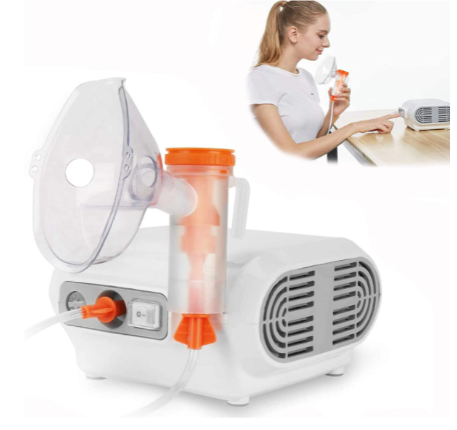
Background
For the second half of ME40: Engineering Design I, we began to work on a project that involved inclusive designs. The class was divided into groups of three and each team was asked to remodel an existing product for a group of our choosing. My team and I decided to re-design a Nebulizer, which is used to liquify medicine, for users with Parkinsons Disease.
With COVID restrictions still in place, we were unable to build a final prototype or run thorough user tests.
Design Challenge
Before begining to ideate new designs, our team had to agree on a user and their needs. Our user was Bill, a 75 year old male with mild tremors.
I began doing research on what products existed for people with tremors, most of which incorporated a self-balancing mechanism. Because the mask used in a nebulizer must be lightweight, made of FDA approved material, and allow vapour out, self-balancing mechanisms would not work well. Additionally, the medication used was transferred via a small cup that required precision. Our team agreed on the following needs:
System Requirements
-
Accessibility: can consistently be operated by someone with mild Parkinson’s
-
Durability: ability to remain functional without excess repair over design lifetime
-
Efficiency: Set up in under five minutes
-
Maintainability: Spend less than twenty minutes a week cleaning
-
Usability: Set up with minimal reference to the owner’s manual
Operational Requirements
-
To deliver vaporized medication efficiently
Functional Requirements
-
Allow for different medication amounts
-
Vaporize medicine
-
Maintain the same outside temperature
-
Hold the same vaporizing speed
-
Receive Power
-
Indicate when the vaporization process is complete
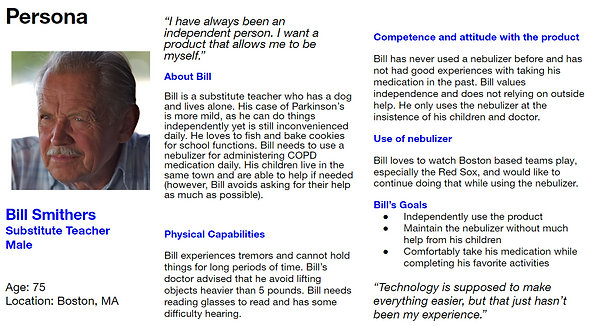
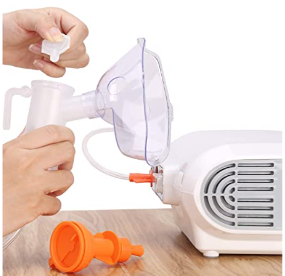

Idea Development and User Testing
Idea Development:
-
Since the medicine cup size is dedicated by the prescription, a funnel was created to put over the cup when the medicine is being poured into the cup.
-
The increased diameter will help prevent spillage for people with tremors.
-
A softer material was added around the cup to make holding it more comfortable and to make the diameter closer to the anthropometric grip measurements chosen for Bill
-
A thicker extension to the band was added to make it easier to adjust the size
-
Taking inspiration from the MagSafe charger, the tubing now connects via magnets (and is sealed with a rubber gasket)
-
An indicator light was added to signify on/off status for an additional visual aid
-
A larger power switch is easier to manipulate for someone with tremors
-
The tab on the filter makes removal easier (no more unsuccessfully pinching at the foam)

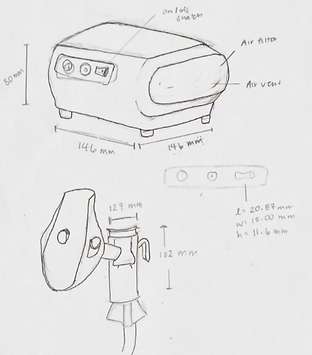
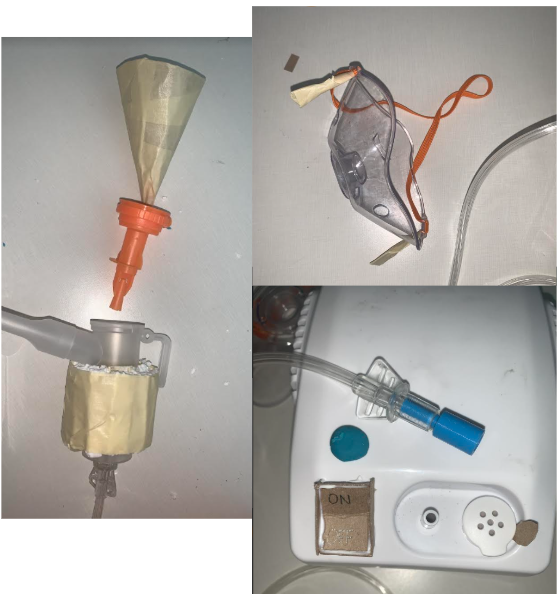
User Testing:
-
We made a prototype with an existing nebulizer to include our design improvements. Users then physically interacted with our redesigned product to provide feedback.
-
User testing protocol is on Canvas
-
We created a link to a video of one of our user tests
-
Our questions were aimed at addressing the efficiency, effectiveness, and satisfaction of the product changes we implemented
-
We conducted user testing on people outside of the class so that there was no bias or previous exposure to the product
-
We realize that our users are more able than our Persona and have taken that into considerations with both our user testing and redesign
Results:
-
Testers found the new hose attachment easy to use and satisfying
-
The funnel made it easier to add medicine to the container
-
One tester worried it might be easy to lose since it is not attached to anything
-
-
A user spilled water on the machine, bringing up the issue of electrical safety
-
Users appreciated how filters were easy for them to remove
-
Prototype was very fragile so the tab didn’t last long (ideally would be made with plastic)
-
-
User also appreciated the larger grips of all attachment parts
Future Work
-
One of our testers suggested that the twist open cup could be challenging to manipulate with tremors
-
Utilize a flip top to make easier to open and close
-
-
The hole in the nebulizer where the power supply connected could be replaced with a conical hole
-
This will help guide the plug into place, giving people with tremors a larger margin of error when plugging in the power cord
-
-
One could reasonably be using this in a bathroom or near other locations with water
-
Add a sticker near the plug warning of shock hazard if subject to water spills or submersion
-
-
These changes fulfill the needs of our Persona who has physical limitation, and help to avoid hazardous incidents